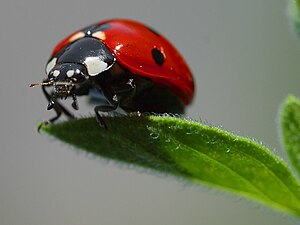 Image by Thomas Hawk via Flickr
Image by Thomas Hawk via Flickr
The Lost Ladybug Project was started at Cornell University and seeks to understand the changes that have been taking place over the past twenty years with ladybugs. Some common ladybugs have become rare, some types have increased in numbers, and others have relocated to new habitats. Ladybugs are important because they help keep plants alive by eating the pest insects (e.g. aphids).
 Image via Wikipedia
Image via Wikipedia
A few years ago, my children's bathroom was infested with ladybugs. I have never seen other bugs in the bathroom and I have no idea how they got in the house. Well, maybe the occasional "Mom! There's a spider in the bathtub!" but this was really strange. We collected and released them and they never came back. Now, I wish I had photographed them!
Some other interesting ladybug facts:
* Over 500 species have been identified in the US; 4500 in the world
* They live up to one year after the pupal stage
* Their predators include spiders, stinkbugs, and toads
* They are part of the beetle family
Happy Ladybug Searching!
Image via Wikipedia



No comments:
Post a Comment